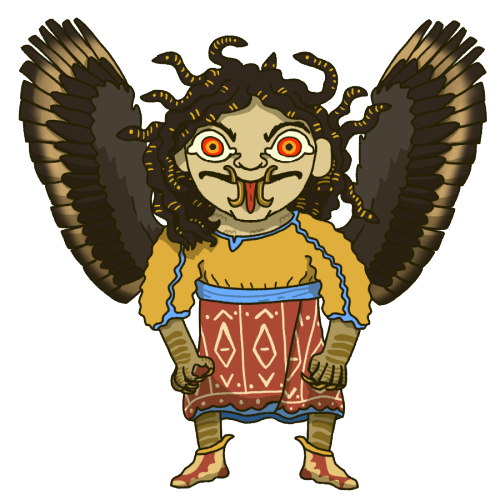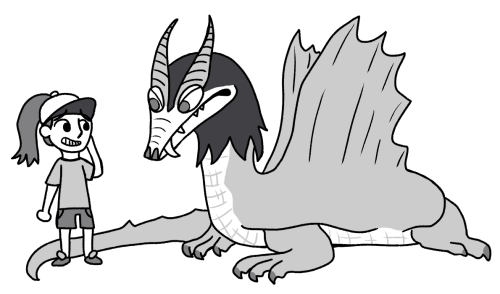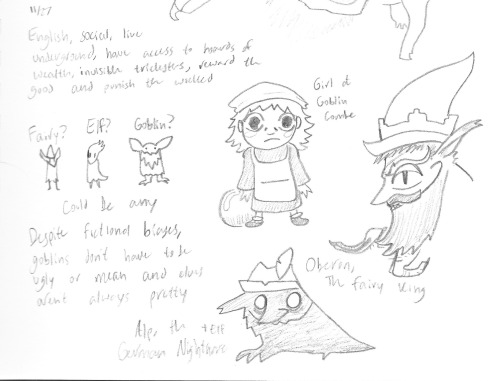#myth stuff
Probably the most famous monster from Greek Mythology is Medusa. Her name has overshadowed that of all other gorgons, to the point where species meant to represent gorgons are just called “medusas”. Across the years, gorgons have changed considerably. While, to my knowledge, there is no exact origin for the monsters, I would hazard a guess that the gorgoneion predates them. The gorgoneion is an apotropaic symbol of a wide, ugly head, sometimes with a beard or tusks, but always with a lolling tongue, curly hair, and wide eyes. Like the evil eye in the modern Mediterranean, the gorgoneion was used as a ward for evil. It was supposed to be so hideous that demons and men alike would cringe in fear when they saw it.
The symbol then evolved into a monster (and in Arkadia was given to Demeter in her wrathful form). Its ability to inspire paralysis with fear was exaggerated into a petrifying gaze. The rest of the gorgon’s body was a bit harder to piece together. For most of history it was just a head. A humanoid head, so obviously it was humanoid, right? Well, one archaic image of Medusa (which we can surmise is Medusa because Perseus is right next to her) shows her with a centaur-like body. After that though, the general consensus became that gorgons had human bodies, with or without wings. Wings were given to a large number of minor gods and goddesses to represent connections to air and traveling fast over large distances, such as the harpies or the messenger Iris. Snakes also got added on. Nearly all gorgons had curly heads of hair. It’s not too much of a stretch to turn that into a viper’s nest of roiling reptiles, further enhancing the scariness of the monster. Partially. Most gorgons have both hair and serpents. As time went on more and more changes and adaptations of Medusa turned her into a metamorphic character. Once that happened, it became popular to depict her as a woman without the monstrous aspects. Whether out of empathy for her or artists wanting to break out of the stylistic gorgoneion in favor of more naturalistic anatomy, who’s to say. This continues to the modern day. Then a snake body below the belt got added for some reason.
Almost all of the focus on gorgons has been, both in this blurb and historically, on Medusa. What about the other gorgons though? Aside from Medusa’s sisters, they don’t count. There is an enigmatic gorgon named Aix in mythology. This gorgon, whether male or female, was on the side of the titans during the Titanomachy, but was killed by Zeus and converted into the aegis. They supposedly had, in addition to the classical gorgon face, hairy skin. Which would explain why their name, Aix, translates to goat. Euripedes introduced a similar Gorgon in the gigantomachy, slain by Athena (who just seems to hate gorgons I guess). Whether it was a giant named Gorgon or a gorgon helping the giants is unclear. Others use gorgons as a sort of stock monster. Virgil mentions multiple generic gorgons alongside other monsters while certain authors claimed gorgons lived on islands off of Ethiopia. And, to bring it back around, Medusa and her sisters were said to be the daughters of the nymph Keto and either the god Phorcys, or some unnamed male gorgon. Wherever we go, we just can’t shake her off!
This gorgon is primarily inspired by one depiction of Medusa. She had wings, snake hair, curly hair, and a stylish outfit, all while she’s running off somewhere. I wanted to keep her hair a bit ambiguous, so you can’t really tell which lock is a snake and which one is regular hair. Her wings are primarily vulturine. She’s also got bronze claws mixed in with scales and a loud outfit. Meeting her in a seaside cave would be a shock to the eyes, for multiple reasons.
Post link
Welp. Remember when I said I’d post the rest of the Greek creatures as a pack you could buy? Maybe not, because I scrubbed that from the post that had it. It turns out I probably don’t have what it takes to make money off art, because I suck at getting anything done unless I have a deadline. And setting ones that only exist in my brain clearly doesn’t work, as the TDG shows… But it also means I’ll be showing off what I did so far without charging. I’ll find money some other way, probably with writing or something.
Sirens, am I right? In myths, the sirens were a variety of nymphs. Like all nymphs they were excellent singers able to lure people away into the wilds. The sirens were especially good singers, but of course they could not compare with the deathless muses. What set them apart from their sisters were their bird bodies and fatal edge to their music. Cursed by Demeter for failing to find her daughter, they were given an island in the Mediterranean as their haunt. They sung to sailors in a bid to make them jump into the tumultuous waters and drown. For seemingly no reason other than their own malice. In pottery their shape is ambiguous. Sometimes it is merely the head of a woman on a bird, other times it’s a sort of bird-centaur shape. When given hands they also may play instruments to enhance their own voices.
As time went on, the sirens began changing into more sea beings than aerial ones. Where once they were merely confined to an island, it was their maritime association that saw them become the mermaids of the Middle Ages. The shape of the mermaid isn’t original to them: Mesopotamian spirits had it long before the sweet-singers, and some Celtic figures may predate the fishy sirens. However, most mermaids have some roots with them. Singing to sailors is especially the key mark, although they do so with a twist of lust in the mix. Siren is even the word for mermaid in many romance languages. When depicted in their original bird forms, they tend to lose the grace and talent they used to possess. Sirens in modern stories are often murderous, eating those they drown. Authors like Rick Riordan reduce them even further to a sort of vulture with only the face of a human.
My siren is the armed sort. I just thought it would look different. Her bird half is inspired by birds of prey more than seabirds, seeing as how they can’t move away from that island of theirs. Her upper half has the porcelain whiteness associated with goddesses and nymphs in ancient Greek poetry. The dryads and naiads don’t have this because they’re less airy and more earthy, but I think the nereids will. Unlike her sisters, she’s enamored with her island home and has taken to using washed up shells as jewelry. Also, her downy feathers extend up her chest because no booba for u.
Post link
A much less pleasant dragon than the ones Drake’s met before. Lamia are creatures of hate and ruin, sucking up water and spitting fire and poison in return from its dog-like head (or heads). Crops, livestock, and even children aren’t safe from them. Children mysteriously dying for no discernible reason are often blamed on the lamia. In its remote homes, beneath the sea or river, or within the mountains, it guards living water, from which plants derive their nutrition. In Bulgaria, it’s reckoned Saint George’s battle was with one of these dragons. While usually reptilian in form, they can take anthropomorphic shape just as easily. It was probably this shape they originated in, deriving from the Ancient Greek lamia and taking on draconic traits as time went on.
Drake may have a special way with monsters, but even he’s wary about her.
Post link
Don’t let the date fool you, this is actually from 11/27/2020. It’s a little experiment using folklore/TDG sensibilities compared to modern fantasy ones.
Quick! You are in the English countryside and have encountered a supernatural being. It is social, lives inside a hill, has access to immense wealth, can become invisible to harass human beings, rewards the good, and punished the bad. Is it:
a) a fairy
b) an elf
c) a goblin?
The answer is… you don’t know! It could be any of the three, as, depending on the specific locality in question, there may not be any meaningful difference between the three. In modern fantasy there is a strong pressure to canonize certain traits to form a homogeneous species out of folkloric stories. Certain names are attached to these and thus come to be synonymous with them. But in the original stories they come from, these names don’t carry as much power as one might think. The story of Goblin Combe shows goblins being just as pretty and sweet as regular ol’ fairies (they do disappear a guy, but that’s on par for fairies). The German Alp is derived from the word “alf”, or elf, and sits on people’s chests to cause nightmares or lick their nipples to draw blood like a vampire bat. And Oberon, aside from his appearance in A Midsummer Night’s Dream, is a dwarf who literally derives from Alberich. Despite what connotations the names might imply they are just names and can change in meaning or be switched around as a story-teller desires. Which isn’t to say that there are no mean and ugly goblins or pretty and winged fairies, just that there is no “one true” version of the creatures.
Another reason why “A Guide to Household & Garden-side Pests” (Anon) is trite, in Dwoll’s opinion. The compilers who stolehis notes (re: found them after he was missing for a while without knowing who wrote them) didn’t have any of the real first-hand experience with the pests they wrote about. So they delineated species and families arbitrarily and failed to acknowledge the flexibility of the supernatural world, which they probably never knew about in the first place! Oooooh it just makes him so mad.
Post link
A little study into the teeth of the axehandle hound. It’s a fearsome critter, a plague upon lumberjacks that specifically only eats the wooden handles of axes. The original description of them gives them an axe-shaped snout. Which got me thinking of the proposals for Smilodon lips. Thus here we have the axehandle hound hiding two rodent-like incisors for chewing and breaking apart its wooden delicacies. Behind them they have inner teeth adapted for grinding, but are still noticeably canine. Their incisors also have high iron content like some rodents but don’t grow throughout their lives.
Originally this was just black and white, but I wanted to try my hand at coloring it. One thing most people tend to miss out on when drawing them is that, while compared to a dachshund, they’re wild dogs. So I wanted to make it look more like a coyote than a beagle. Unfortunately… coyote fur is really hard to draw. Wolves as well. They’ve got this really complex fur where there are individual strands of hair colored differently right next to each other. Which is super time-consuming to draw. I tried my best to render it without straying too far from the line-art style, but it still doesn’t look nearly as good. Oh well. For one of the TDG stories, an axehandle hound plays a central role. If only I’d get around to writing it.
Post link
There were quite a few types of giants in Greek mythology (including our last boy the cyclops), but the gigantes were the most famous and exemplative of their kin. They even lend their name to the word giant. Originally the “gigant” didn’t relate to size but rather their origin: they were earth-born. Gaia (or Ge/Gi) birthed them straight from the ground. Gigantes erupted from the surface like reverse meteors intent on storming Olympus. Their kind had no women. Instead they came into the world fully formed and armed. Of course, they failed. They were killed by the gods and sealed beneath islands or into volcanoes. From their ashes came a race of humans just as violent, the Thracians. Or so the Greeks said. Volcanic activities were usually associated with the gigantes like the Phlegraean Fields in Italy.
The earliest of their depictions have them as being spear-wielding men. Normal men, for the most part. Some, like Homer’s Odyssey, claim that they were in some way more brutish or bestial than human beings and their gods, as the Laestrygonian giants were “looking not like men but like the lawless Gigantes.” To reflect this, they were sometimes given less advanced armaments like animal furs and rocks. The last big change to the gigantes were their distinctive snake feet. As said before, the giants were born directly from the earth, like the Athenian Kekrops and spartoi. Snakes (and dragons) too were thought to be born directly from the Earth, so giving them snake for feet was a sort of visual metaphor for their birth that inevitably lost its meaning and simply became a trait of theirs.
Once Christianity became the dominant religion of Greece, the gigantes did not leave. Instead they changed enemies. After all, this is just one god, it’s bound to be easier than fighting all the rest! Right? …right?
This gigant is of the older type. Based on the standards of his brothers he is a veteran for surviving two charges on Olympus. To show he’s not just human, his skin is closer to stone with scars showing up like cracks. If you were to touch him, his hair would be like fiberglass and his entire body hot to the touch, for molten rock flows in his veins in the place of blood. His dinged up armor is inspired by Peter Connolly’s The Legends of Odysseus for the Bronze-Age aesthetic. His shield also used to have a snake on it for his mama, but it got blown asunder by a thunderbolt. He had to skin an entire cow for a replacement. And… I tried. I tried to make the snake-legs work, but I simply couldn’t. Perhaps one day when I am strong enough.
Post link
Cyclopes (the plural of Cyclops) range from either strong allies of the gods to theologically ambivalent savages. The latter are the less divine and will be focused on here. Though they may have some relationship to the gods, they do not live like their semi-divine cousins. The clearest view we get of them is from the Odyssey. Here they live on remote islands without human neighbors, tending sheep or, presumably, living and preforming other similarly archaic ways of life. The cyclopes have no agriculture, harvesting only what grows naturally, no metal-working, no sailing or ships, and no laws. Or rather, their laws are those of the house, not the village or state. Every cyclops home is a governance unto itself with the head of the household being the “king”. He dictates the rules to his family and has final say. Other households do not regard other’s rules. But, they seem to be friendly enough, despite that. Polyphemus was unique in his aloofness towards the other cyclopes.
One thing that rung true was their ignorance to the laws of the gods. The Greek gods were the sources and enforcers of the laws of civilization. Zeus especially laid the rules for hospitality and good conduct between people. Our cyclopes have no concept of that, and treat the gods as equivalent beings, weaker than themselves. Which is why Polyphemus eats Odysseus’ crew with no sense of remorse, because Zeus will not raise his hand to punish him. Or, so it seems. Polyphemus does get punished for his evil deeds through the free will of his captives, thus enacting the same punishment the gods would bring. After this, the other cyclopes tell him, “If no man is doing you violence–if you are alone–then this is a malady sent by almighty Zeus from which there is no escape; you had best say a prayer to your father, Lord Poseidon.” The facade is thus broken. Even the strongest beings bend to the rules of the gods like the rules of physics. Only Polyphemus was so naive as to think himself above the consequences of his actions. Whether or not the rest of the cyclopes were as grim monsters as him is debatable, but the Greek did not have high opinions of their kind.
While not doing any smithing, I like the design of cyclopes with brick-red skin. It sets them apart from other humanoid-looking beings. This guy is a shepherd, obviously, complete with shears and a sheep. Where did the metal come from? Idk man, the sky? His hands are bruised and scarred from many years of shearing and dealing with ornery flocks. And his legs are bare of hair and columnar, better to support his immense weight. Will he eat you? Maybe not, but he definitely won’t appreciate you in his cave.
–
In other news, I’ve decided what I’m going to do with these. I’m going to do a few more and release them as a token set. Whether on dmsguild or roll20 or gumroad, I don’t know. There will be a total of 18 drawings of different Greek mythology “humanoids”. I plan of having six free samples, these and the next one, the gigantes. Maybe I’ll expand to different things as well. Sadly won’t allow me to gush and write entries like this, but c'est la vie.
Post link







